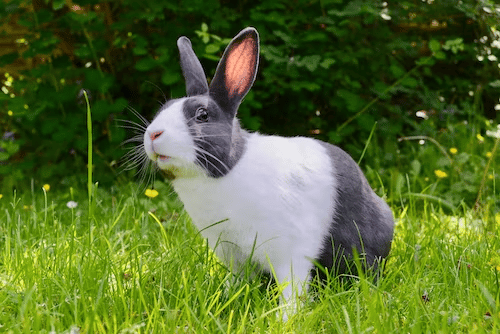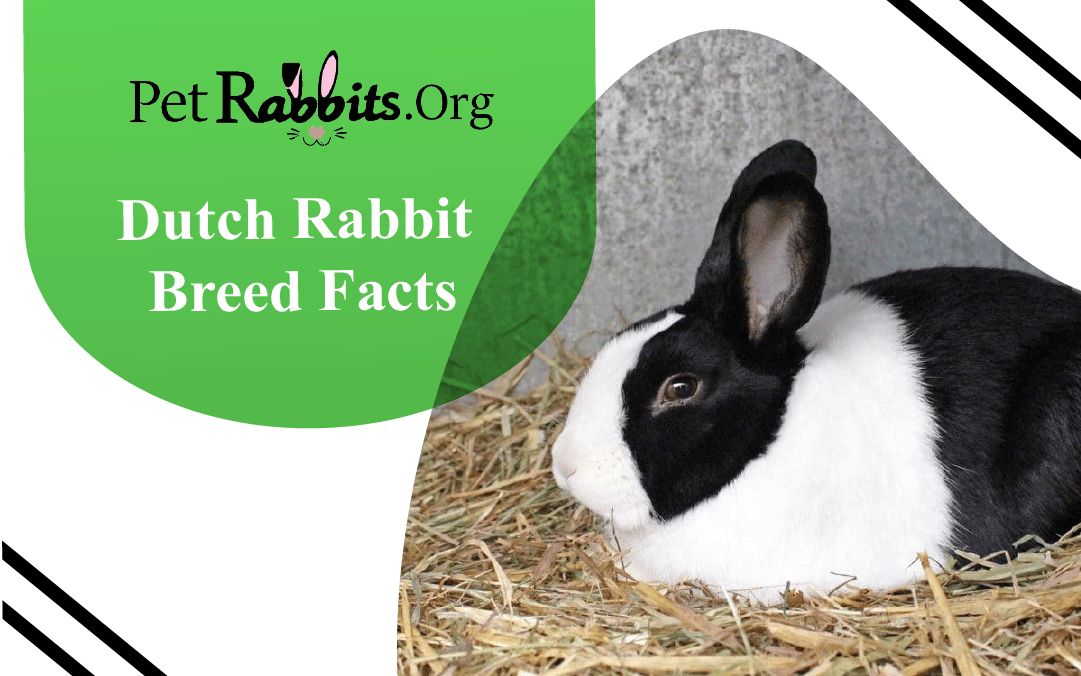The ideal shape of a Dutch rabbit is rounded and balanced. Dutch rabbits weigh between 3.5lbs to 5.5lbs and have distinctive markings making them unforgettable. For instance, you can assume you have a Dutch rabbit if they have a white blaze on its nose, a white saddle on its back, and a white collar around its neck.
History of the Dutch Rabbit
Despite the rabbit’s popular name, it was originally developed in England. The rabbits have seven color variants, and they were among the first to be recognized by ARBA’s precursor in 1990.
Recognized color variants include chinchilla, chocolate, blue, black, tortoise, and steel. Recognized eye colors include those between brown to brown-ruby, dark brown, or grey. How long do rabbits live? The rabbits have an 8 to 10-year lifespan, can have blue eyes, and are related to the Brabancon breed.

Dutch rabbits are small breeds; however, they aren’t dwarfed like the Netherland dwarf rabbit. They have normal-length fur and a soft underlayer protected by guard hairs. The rabbits have flyback fur, meaning it snaps back to its original position when brushed in the opposite direction of growth. They also have upright ears.
Do Dutch Rabbits Make Good Pets
Are Dutch rabbits friendly?
People consider Dutch rabbits are friendly, intelligent, and easygoing. However, generalizations have exceptions, and your rabbit could display characteristics other than those mentioned above. You should discuss the rabbit you want to get with the provider and observe for a few minutes before making the purchase.
Additionally, you should learn about your rabbit and earn their trust before attempting to pick up or touch them. Give them time and space to learn and adapt to your home before introducing them to other family members. You should also observe them and learn about their likes and dislikes.
Allow them to interact with you on their terms, move cautiously around them, and learn how to properly pick them up before attempting to do so. Here, you can get more information about rabbits and their behavior, like why rabbits thump their feet.
How to Care for a Dutch Rabbit
Caring for your dutch rabbit involves providing them with healthy foods and a loving and safe home. Combine these with a few extra acts of care, and your Dutch rabbits will surely thrive.
What to Feed a Dutch Rabbit
Primarily, rabbits eat hay, and you should always provide them with clean water and fresh hay. The type of hay you provide your rabbits depends on various factors. For instance, you should provide healthy adult rabbits that aren’t nursing with fresh hay. Types of hay include orchid, oat, timothy, etc.
Sick, young, and nursing rabbits need more calories, calcium, and proteins in Alfalfa hay. Additionally, you should provide your Dutch rabbits with hay since their teeth grow constantly, and chewing on hay wears them down. It also helps prevent several dental issues.
You should provide them with vegetables and leafy greens. You can also give them some fruits; however, you should give them in small quantities since fruits contain lots of sugar. Give your Dutch rabbits fruits as treats and consult a vet regarding which fruits and vegetables are safe for your rabbit.
Provide your Dutch rabbit with pelleted foods in small quantities. They are an important part of your rabbit’s diet since they provide minerals and vitamins essential to their health.
Cleanliness and Living
Your dutch rabbit should live in a comfortable and spacious hutch with clean beddings, a litter box, water, food, hideaways, and toys. These include an exercise pen, a rabbit-proofed room, a large cage, or any other type of housing that fits your home. You should keep their place clean, and place it in the best location.
You should do daily spot cleaning, clean it weekly, and deep clean each month. Doing this keeps your rabbits healthy and happy. Additionally, Dutch rabbits are social creatures and will be happier if they hang out with other rabbits. The Dutch rabbit breed is one of the best rabbits used for pets.
You should also play, pet, and hang out with them whenever possible. Also, you can adopt multiple bunnies; however, you should check to ensure they get along. You should also separate them by sex and have them neutered or spayed to prevent unwanted pregnancies. Make sure to trim their nails, and brush their fur to prevent mats and keep them healthy.
Do Dutch Rabbits get Along with Other Pets?
Dutch rabbits are gentle, and can get along with other pets. The rabbits prefer a companion to live with, and most experts believe they live longer if they have a companion. You could pair them with other pets in your home; however, you should avoid pairing them with dogs since they have an instinct to hunt rabbits.
You should also avoid pairing them with cats since they could harm or attack the rabbits. You could pair them with other pets like ducks, guinea pigs, and chinchillas that don’t have the instinct to hunt.
You should also check out for various diseases like:
- Respiratory diseases
- Obesity
- GI issues
- Breeding
Owning a Dutch Rabbit
There are many types of rabbits, including the Lionhead rabbit and the Holland lop rabbit or the flemish giant rabbit, Rex Rabbit as well as the angora rabbit. Unlike having a cat or dog, keeping the Dutch rabbit or any of the others mentioned above isn’t as cliche. You can hold and run your fingers through their fur whenever you want to relax and decompress. What type of rabbit would you want to have as your pet?
I have always loved rabbits. A rabbit was my very first pet. Since owning my first rabbit I have gone on to own many more. I look forward to being able to get my kids their very own pet rabbits.


Recent Comments